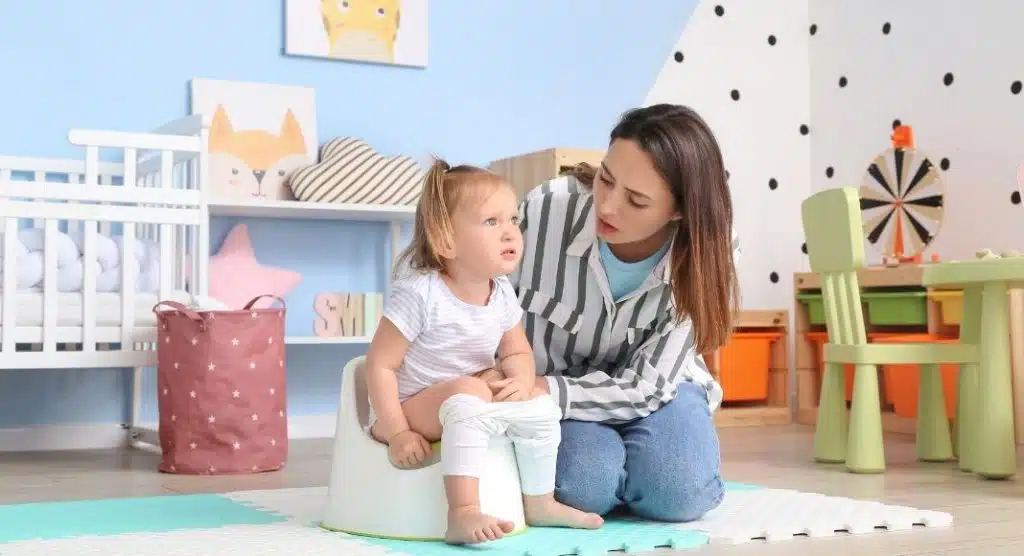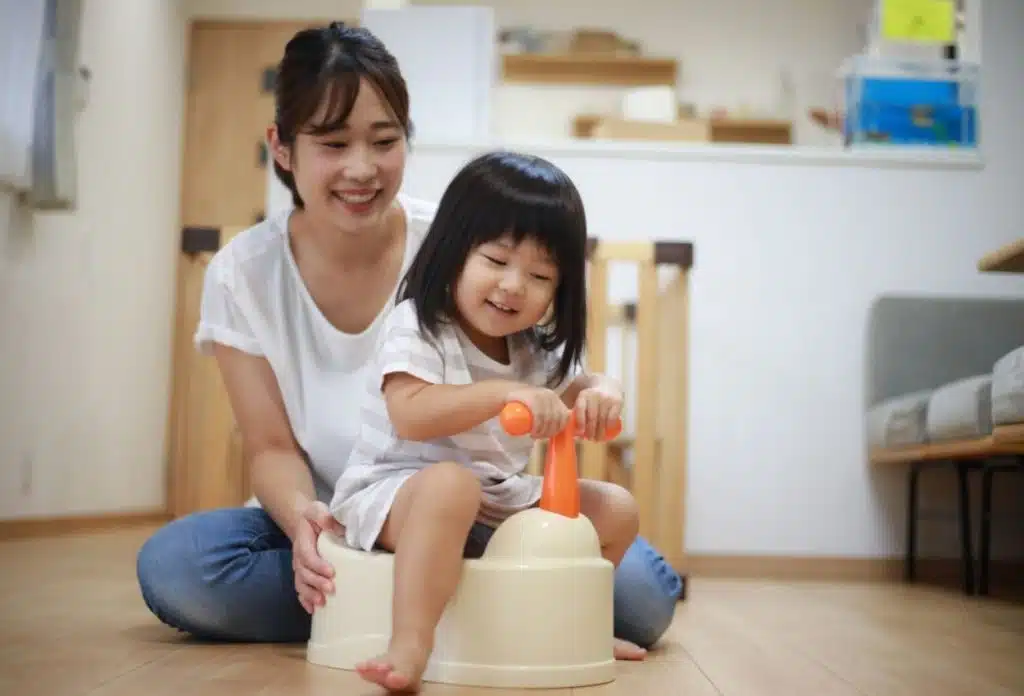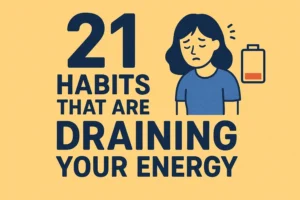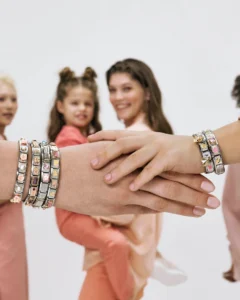How to Start Potty Training – Best Tips and Tricks
By TOI Desk Report
April 20, 2022
Update on : April 20, 2022

Toilet training your toddler is a learning experience for both parents and caregivers, just as perching on a potty is a new skill for your child. Toilet training is an exciting moment for everyone involved since it signals the beginning of a journey toward independence and potty training.
Potty training doesn’t have a set age; some children start using one at 18 months, while others don’t start until they’re three years old.
When it comes to determining when to start toilet training, the behavior might be a greater indicator than age. Learn the symptoms in our article on when to start potty training.
If your kid is ready, it’s time to look into toilet training methods, but even then, each child is unique. If you’re trying to potty train a stubborn three-year-old or get a four-year-old to defecate on a toilet, you might need to be more careful.
Commitment is essential after you’ve decided it’s time. Set aside a few days and prepare to lavish praise on your child. The following are some of the basics covered in this article:
- How long does it take to potty train a child?
- Using potty training charts is a great way to help your child learn how to use the toilet.
- Potty training overnight
When it comes to toilet training, how long does it take?
There is no correct answer to this question; it varies based on the type of parent and the child’s personality. Here are some suggestions for getting there within a certain amount of time.
Potty training in one day
Potty training a kid in a day is not for everyone, since not all youngsters can quickly master this ability. Learning the fundamentals might take weeks, and staying clean can take anywhere from three to six months. Still, it’s worthwhile to give it a go. If the experience is good, a one-day toilet training session could lay the groundwork for a long-term plan.
Follow these steps to toilet train your toddler in one day:
Set up the potty in your home at least a week ahead of time. Your inquisitive adolescent must get used to it.
Explain why you’re using the potty and show your child how to use it. Inform them of your plans. Children learn by watching and copying, and they will be less humiliated because of this.
Explain to your child what he will be learning. In the morning, they say farewell to their final day coat.
Don’t overdress him. From the beginning, use girl or boy panties. It’s OK for kids to run around in their trousers, but they must get used to wearing them.
Plan activities that are close to the toilet and on solid ground.
Sit your kid on the toilet after a large drink while they watch something entertaining. It encourages toddlers to sit on the toilet and rewards them for doing so.
Praise them when they pee in the toilet. After all, it’s a huge accomplishment.
Every 20 minutes, set a timer, then seat your kid on the toilet and start again.
Ask your youngster if he wants to go potty after a few hours. Keep asking, since busy boys and girls are prone to forgetting. Read more about the paths of the healthy couple.
Potty training in three days
Some youngsters may just need one day to grasp the toilet and begin informing you when they need to go. It’s a fantastic indication. However, most youngsters need three days or more to integrate this information.
Follow these instructions for three-day potty training:
Day 1: Keep your kid near the toilet, offer “in-flight entertainment” while he’s on the throne, and allow him to wear just his trousers for girl or boy. Encourage him to drink lots of water throughout the day, but don’t push him too hard just to encourage him to use the restroom. While he is playing, have him sit on the toilet every 20–30 minutes.
Day 2: Show him how to put his underwear on the toilet while also teaching him how to take them off. After that, assist him with using toilet paper and washing his hands. Congratulate your child on each accomplishment. Pee and poop should be put in the potty when they happen, and you should do the same next time.
Day 3: Take a break from the timer. Take your toddler to the toilet as frequently as possible, particularly after meals, but try to teach him to notify you when he has to go.
Potty training in a week
Potty training might be a more relaxing experience if you have a bit more time on your hands. Trying to potty train an uncertain child too rapidly may cause stress and confusion, which can lead to a loss of confidence. To prevent too much stress, it may take a week or longer to potty train your kid.
As a starting point, consider the following steps:
Day 1: Play around with the notion of toilet training. Telltales about your child’s toys needing to pee or defecate and hurriedly running to the toilet.
Day 2: Remove the diaper and place your child on the toilet every 20–30 minutes. Make it as enjoyable as possible.
Day 3: Talk about bathroom urges and introduce underwear. When an accident occurs, explain rather than yell.
Day 4: If all goes well, go for a stroll in the park. For more information, see our guide to toilet training outside the house.
Day 5: Talk to your child about remaining clean after using the toilet and reassuringly explain how the ‘big potty,’ such as flushing the toilet, works.
Using Charts for Potty Training
Young children like being praised and rewarded. Maybe this is why toilet training charts are so popular. These brightly colored aides assist parents and children in keeping track of their growth. Parents of children who have a lot of accidents would appreciate a toilet training incentive chart.
For additional information, see our guide to typical toilet training concerns. Set a goal for your youngster before using a reward chart. Do you want your four-year-old to always poop on the toilet, or do you want your two-year-old to have dry days? Your kid will choose what’s best for your family.
Hang the chart where your kid can see it and reward him or her with stickers or crayons. Consider combining them with additional incentives, such as a visit to the leisure center if five stickers are collected. It is hoped that by doing so, youngsters will learn to link this conduct with pleasant experiences.
Adopting incentive charts has advantages and disadvantages. While most children react positively, other experts believe that linking actions with incentives might undermine the natural drive to use the bathroom. However, this does not rule out the possibility of using the charts as part of a healthy toilet training practice. Balance the stickers with praise and explanations about why toilet training is so important.
Potty training tips to get you started
It is a new experience for mom, dad, and the kids so use these methods to talk about the highs and lows:
- Use activities to make the procedure more entertaining and thrilling for your child. For ideas, go through our toilet training songs and movies.
- Toddlers should not be forced to go to the bathroom. The Children’s Bowel and Bladder Charity has a good resource for parents of older kids who don’t go to the bathroom.
- Sharing is caring – If your infant has older siblings who have previously been trained, let them see the potty training process from a young age.
- Potty training trousers may help kids manage their bodies, but they should only be used as a substitute for underwear, not diapers. Your youngster should be taught to use the toilet at all times.
- Keep your kid calm: If your child sits on the toilet and does nothing, praise him for trying, then let him play and try again.
Nighttime potty training
For a few months after completing daytime toilet training, most children may need a diaper at night. It’s perfectly natural. Before the age of five, many children are not entirely potty trained at night.
To understand more about bedwetting in children, read our bedwetting in children guide. Your kid will eventually be able to remain dry all night and may even request that you stop using diapers. After all, clean underwear makes them feel like adults.
It’s now time to start looking at new toilet training approaches for evening students. Check to see whether you have:
- A mattress protector that is waterproof
- Extra sheets and duvet coverings
- Pull-down two-piece pajamas or a nightie for your little apprentice—no more onesies! as well as extra components in the event of an accident.
- Toilets are easily accessible. Make sure your child’s route to the restroom is well-lit and secure, or keep the toilet close by.
Begin by bringing your kid to the bathroom before bed, and then let them pick their own underpants for the first time.
Conclusion
You have the ability to establish optimum settings for toilet training. Your kid, on the other hand, is the one who determines when he will be toilet trained. You can just stand by and watch. It’s something that enables a youngster to feel successful and assertive. So don’t be swayed by a power struggle; instead, meticulously document each achievement. In the end, you are and will continue to be, the most important supporter of your child’s growth.

















